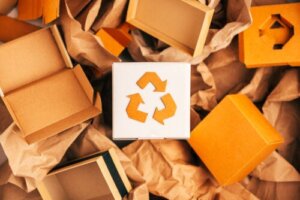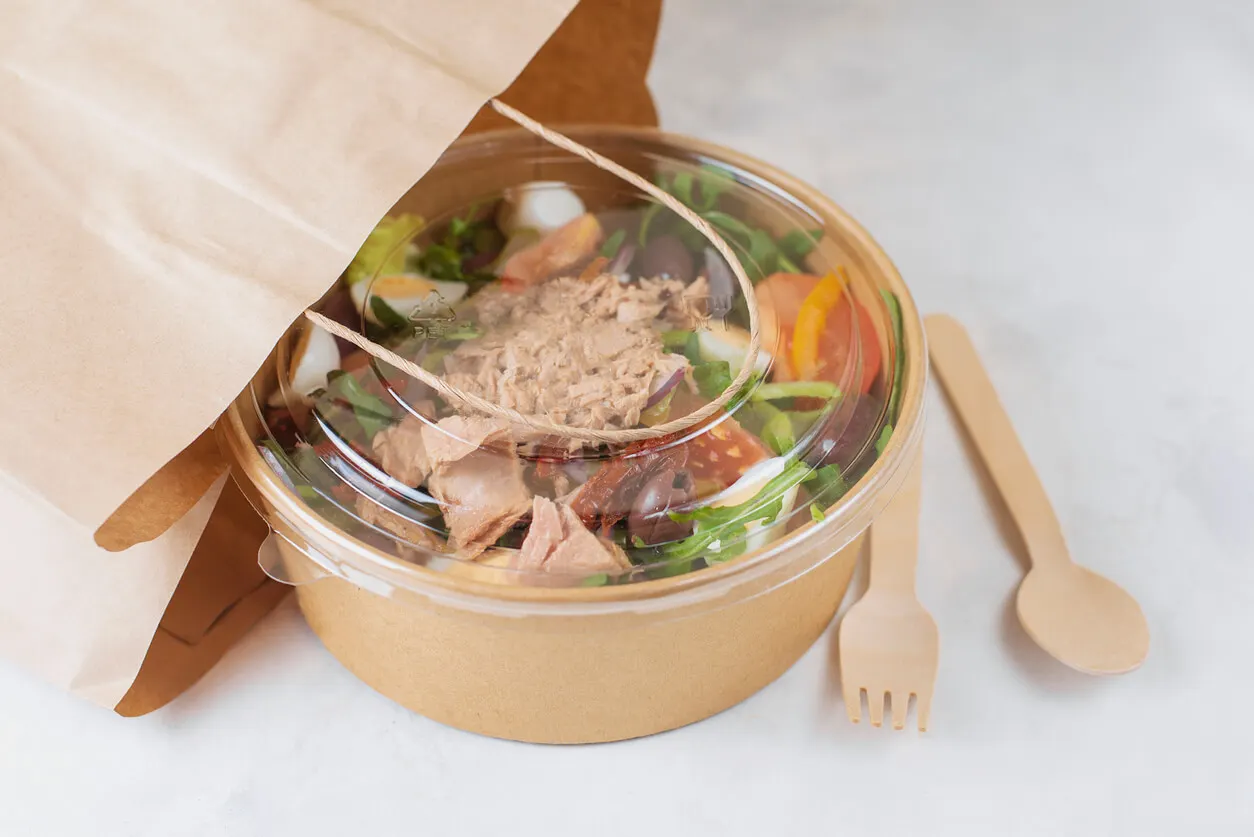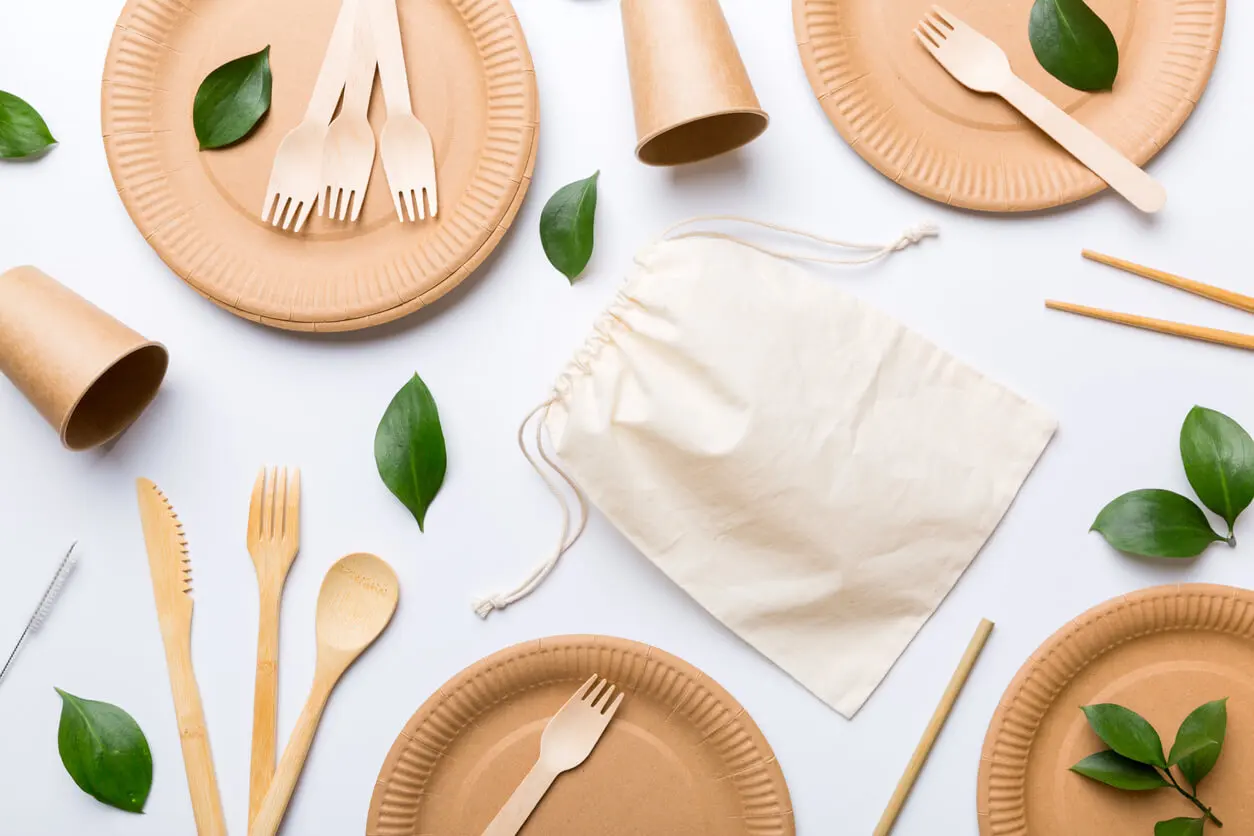7 Types of Organic Food Packaging and What to Avoid


Reviewed and approved by the doctor Leonardo Biolatto
The use of plastic is one of the most urgent environmental problems that humanity must face in order to reduce global warming. Much of this waste comes from the food industry and its packaging. Therefore, it’s important to know the types of organic food packaging.
Millions of tons of plastic waste stagnate in the seas, affecting both human and animal health. The long degradation time of this material leads to the search for alternatives for the storage and transport of food.
Glass, stainless steel, wood, and bamboo have all been presented as viable options.
What types of organic food packaging exist?
Organic food packaging refers to food containers that are less polluting than those whose raw material comes from fossil fuels. They’re presented as an alternative to plastic packaging, which accounts for 40% of the total production of this material, according to a study published in ScienceDirect.
There are many materials considered more environmentally friendly than plastics in terms of food packaging. These include glass, bamboo, wood, and stainless steel. Using them has many advantages, such as the fact that they have a shorter decomposition time, which means they are biodegradable or compostable.
On the other hand, they don’t interfere with the taste of food and can withstand high temperatures. Although, depending on the material, they have a shorter durability. However, environmental care is one of the most relevant reasons to habituate everyday consumption towards ecological types of food packaging.
You might be interested in reading this article, too: How to Make Organic Bocashi Fertilizer
Why are the different types of green food packaging necessary?
According to another study by ScienceDirect magazine, it’s estimated that between 4.8 and 12.7 million tons of plastic end up in the oceans each year. This has generated a historical accumulation in different sectors of the planet, where there are already at least five islands formed by plastic waste.
Such waste takes years and sometimes decades to degrade. However, due to its exposure to ultraviolet radiation, wind, and wave abrasion, the material fragments into particles called nanoplastics.
These tiny pieces affect the aquatic ecosystem, are ingested by marine fauna, and then are consumed by humans. This hs been proven by several scientific studies.
The toxicity of plastic packaging
Another reason to reduce the consumption of plastic packaging is that dozens of chemical substances used in its production are harmful to human health. According to this study, 906 polymers, adhesives, and other chemical additives are involved in the composition of plastic packaging.
Of that total, 63 rank highest in terms of human health hazards and 68 in terms of environmental hazards. And this is only taking into account intentionally added chemicals.
There are other impurities that arise during the manufacturing process or are a by-product of the breakdown of additives. These are known as unintentionally added substances, or NIAS, and represent other hazards that are difficult to determine and investigate.
7 types of environmentally friendly food packaging
According to UN reports, one million plastic bottles are purchased worldwide every minute, and 500 billion bags are used. Reducing single-use plastics is a daily task that also applies to food packaging.
Several studies have analyzed more environmentally friendly alternatives for storing, preserving, and transporting food. Some of the materials used are biopolymers based on cellulose nanofiber and essential oil, among other components. Wheat, wood, and bamboo are positioned as elements from which to make biodegradable packaging.
That is, they decompose in natural environmental conditions, thanks to the action of biological agents such as fungi, plants, bacteria, animals, and the sun. These containers have fewer chemicals than plastics and are therefore good for human health and the environment.
1. Wooden plates and containers
Wooden containers are reusable, i.e. they’re not discarded after the first use. A study published in ScienceDirect showed that wheat pulp packaging and wooden plates are safe for human health. Although they contain some chemicals, the transfer to food is much lower compared to plastics.

2. Glass bottles
Glass is a durable, resistant, recyclable material with multiple uses. According to this study, glass containers dedicated to food are recommended. This is due to its antibacterial properties and low migration of toxic substances into the food.
Glass bottles are increasingly used and there are many designs for all occasions. However, special attention must be paid to their sanitization to avoid the accumulation of bacteria in the spout.
3. PLA cups
PLA cups are very similar to the common ones, have a transparent shade, and are ideal for water, juices, and any cold drink. More and more people are using them because of their compostability. That is, they degrade in natural environments and in a short time.
In addition, they work for the formation of compost in composting plants. They are made from an environmentally friendly polymer from potato starch, corn starch, and other plants. A variant with other additives, called CPLA, is also used to withstand higher temperatures.
4. Types of organic food packaging with rice husks
Packaging made from rice husks, obtained from rice cultivation, is biodegradable, economical, and resistant. In addition, a scientific study proved that this absorbent material has the potential to eliminate several contaminants. Different containers for food transfer are available for sale.
5. Bamboo
Bamboo fibers are widely used for making biodegradable packagings, such as bowls, boxes, lids, and jars. A study published in ScienceDirect highlights its mechanical and thermal properties as very advantageous for this purpose. However, it has the disadvantage of wearing out faster than other materials.
6. Sugarcane
Sugarcane bagasse is a collection of fibers left over from the industrial processing of sugarcane. This material has begun to be used as a base for the manufacture of plates and containers for food distribution. Research has proved its potential for storage thanks to its resistance to high temperatures.

7. Stainless steel
There’s nothing better than a resistant, durable, stainless, and reusable material for food storage. This is an option available for items such as lunch boxes and thermoses. In addition, containers with airtight lids are often used for storing grains, flour, and spices.
Single-use plastics: What are they and which ones we should avoid?
These are objects made of plastic materials, made from petroleum derivatives, which are discarded after the first use. This causes serious damage to the environment since they take years and even decades to degrade.
However, this isn’t the only danger that these objects represent, since the packaging of food in plastic carries the risk of transferring toxic substances. Numerous studies, such as the one published in the scientific portal Environmental Health, prove that materials in contact with food are a route of exposure to hazardous chemicals.
This includes some known and others that have not been toxicologically characterized. Therefore, it’s advisable to avoid the consumption of the following single-use plastics:
- Disposable cups and cutlery
- Straws
- Wrappers
- Bottles
- Bags
Tips to stop using plastic and use other types of eco-friendly food packaging
There’s new legislation in Spain and the European Union that limit the sale of single-use plastics. However, there are also individual actions that can be taken in everyday life. For example, carrying cloth shopping bags and using recyclable or reusable hygiene items can help.
In terms of food, it’s important to avoid single-use utensils and packaging by prioritizing ecological types of food packaging. These objects are increasingly manufactured and marketed, so the available offer is diversified.
All cited sources were thoroughly reviewed by our team to ensure their quality, reliability, currency, and validity. The bibliography of this article was considered reliable and of academic or scientific accuracy.
- Lourdes Morillo-Velarde Martínez. EFECTOS POTENCIALES DE LOS MICROPLÁSTICOS EN LA SALUD HUMANA. Departamento de Química Inorgánica, Facultad de Farmacia. Universidad de Sevilla. Disponible en: https://idus.us.es/bitstream/handle/11441/133051/MORILLO%20VELARDE%20MARTINEZ%20LOURDES.pdf?sequence=1&isAllowed=y
- Groh, Ksenia J et al. “Overview of known plastic packaging-associated chemicals and their hazards.” The Science of the total environment vol. 651,Pt 2 (2019): 3253-3268. Disponible en: 10.1016/j.scitotenv.2018.10.015
- JENNA R. JAMBECK , ROLAND GEYER, CHRIS WILCOX, THEODORE R. SIEGLER, MIRIAM PERRYMAN, ANTHONY ANDRADY, RAMANI NARAYAN, AND KARA LAVENDER LAW. Plastic waste inputs from land into the ocean. SCIENCE. 13 Feb 2015, Vol 347, Issue 6223. pp. 768-771. Disponible en: https://pubmed.ncbi.nlm.nih.gov/30463173/i/abs/10.1126/https://pubmed.ncbi.nlm.nih.gov/30463173/science.1260352?siteid=sci&keytype=ref&ijkey=BXtBaPzbQgagE
- Muncke, Jane et al. “Impacts of food contact chemicals on human health: a consensus statement.” Environmental health : a global access science source vol. 19,1 25. 3 Mar. 2020. Disponible en: https://www.ncbi.nlm.nih.gov/pmc/articles/PMC7053054/
- Alizadeh-Sani, Mahmood et al. “Eco-friendly active packaging consisting of nanostructured biopolymer matrix reinforced with TiO2 and essential oil: Application for preservation of refrigerated meat.” Food chemistry vol. 322 (2020). Disponible en: https://pubmed.ncbi.nlm.nih.gov/32305879/
- Asensio, Esther et al. “Migration of volatile compounds from natural biomaterials and their safety evaluation as food contact materials.” Food and chemical toxicology : an international journal published for the British Industrial Biological Research Association vol. 142 (2020). Disponible en: https://pubmed.ncbi.nlm.nih.gov/32474024/
- Demirel, Barış, and Melek Erol Taygun. “Production of Soda Lime Glass Having Antibacterial Property for Industrial Applications.” Materials (Basel, Switzerland) vol. 13,21 4827. 28 Oct. 2020. Disponible en: https://www.ncbi.nlm.nih.gov/pmc/articles/PMC7663106/
- Shamsollahi, Zahra, and Ali Partovinia. “Recent advances on pollutants removal by rice husk as a bio-based adsorbent: A critical review.” Journal of environmental management vol. 246 (2019): 314-323. Disponible en: https://pubmed.ncbi.nlm.nih.gov/31185318/
- Hai, LeVan et al. “Green nanocomposite made with chitin and bamboo nanofibers and its mechanical, thermal and biodegradable properties for food packaging.” International journal of biological macromolecules vol. 144 (2020): 491-499. Disponible en: https://pubmed.ncbi.nlm.nih.gov/31857175/
- Brown-Gómez A, Álvarez-Delgado A, Leal-Alfonso J. A, Gómez-Estévez A, Renté-Zamora A, Rodríguez-Dorrego M. E, Pajes-Castro R, Matellanes-Iglesias L, , Villlamil-Nuñez W. Fibras de bagazo como refuerzo en materiales termoplásticos. ICIDCA. Sobre los Derivados de la Caña de Azúcar [Internet]. 2011;45(1):29-36. Recuperado de: https://www.redalyc.org/articulo.oa?id=223122251004
- Salinas, Manuel. (2019). Planta de producción de ácido poliláctico (PLA) a partir de ácido láctico. Universidad de Sevilla. Disponible en: https://biblus.us.es/bibing/proyectos/abreproy/92571/fichero/TFG-2571-NU%C3%91EZ.pdf
- ONU. Compromiso mundial para reducir los plásticos de un solo uso. 2019. Disponible en: https://news.un.org/es/story/2019/03/1452961
- ONU Refugiados. Isla de plástico: ¿qué es y cómo nos afecta? 2019. Disponible en: https://eacnur.org/blog/isla-de-plastico-que-es-tc_alt45664n_o_pstn_o_pst/
- FAO. LOS MICROPLÁSTICOS EN LOS SECTORES DE PESCA Y ACUICULTURA. 2017. Disponible en: https://www.fao.org/3/ca3540es/ca3540es.pdf
- Houska, Catherine. (2011). Ventaja ecológica del acero inoxidable. Nickel Institute. Disponible en: https://iminox.org.mx/aplicainox/wp-content/uploads/2011/05/ventecol.pdf
This text is provided for informational purposes only and does not replace consultation with a professional. If in doubt, consult your specialist.








